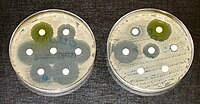
Photo from wikipedia
Infections with Neisseria gonorrhoeae, a sexually transmitted pathogen that causes urethritis, cervicitis, and more severe complications, are increasing. Gonorrhea is typically treated with antibiotics; however, N. gonorrhoeae has rapidly acquired… Click to show full abstract
Infections with Neisseria gonorrhoeae, a sexually transmitted pathogen that causes urethritis, cervicitis, and more severe complications, are increasing. Gonorrhea is typically treated with antibiotics; however, N. gonorrhoeae has rapidly acquired resistance to many antibiotic classes, and lineages with reduced susceptibility to the currently recommended therapies are emerging worldwide. In this review, we discuss the contributions of whole genome sequencing (WGS) to our understanding of resistant N. gonorrhoeae. Genomics has illuminated the evolutionary origins and population structure of N. gonorrhoeae and the magnitude of horizontal gene transfer within and between Neisseria species. WGS can be used to predict the susceptibility of N. gonorrhoeae based on known resistance determinants, track the spread of these determinants throughout the N. gonorrhoeae population, and identify novel loci contributing to resistance. WGS has also allowed more detailed epidemiological analysis of transmission of N. gonorrhoeae between individuals and populations than previously used typing methods. Ongoing N. gonorrhoeae genomics will complement other laboratory techniques to understand the biology and evolution of the pathogen, improve diagnostics and treatment in the clinic, and inform public health policies to limit the impact of antibiotic resistance.
Journal Title: Annals of the New York Academy of Sciences
Year Published: 2019
Link to full text (if available)
Share on Social Media: Sign Up to like & get
recommendations!